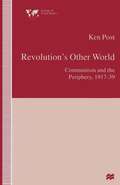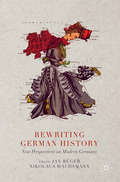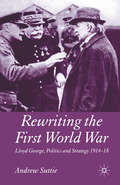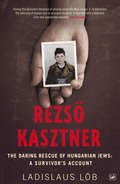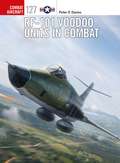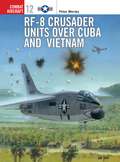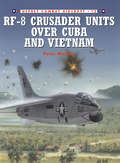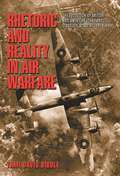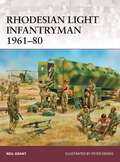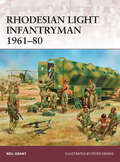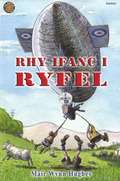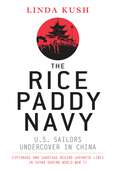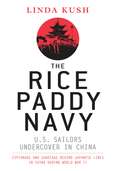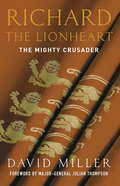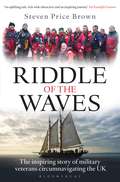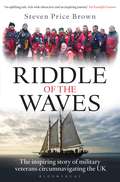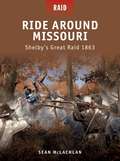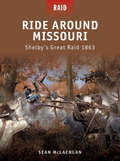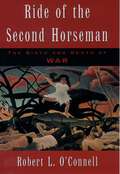- Table View
- List View
Revolution’s Other World: Communism and the Periphery, 1917–39 (Institute of Social Studies, The Hague)
by Ken PostKen Post examines the 'turn to the East' by the international communist movement in fostering world revolution after the success in Russia in 1917, which led to communism's greatest gains after the Second World War. Based on a theorisation of the building of revolutionary movements, this study critically assesses communist strategy and tactics using three key cases, China, India and Brazil, drawing out implications for possible future developments in less-developed countries.
Rewriting German History: New Perspectives on Modern Germany
by Nikolaus Wachsmann Jan RügerRewriting German History offers striking new insights into key debates about the recent German past. Bringing together cutting-edge research and current discussions, this volume examines developments in the writing of the German past since the Second World War and suggests new directions for scholarship in the twenty-first century.
Rewriting the First World War: Lloyd George, Politics and Strategy 1914-1918
by Andrew SuttieThis book assesses Lloyd George's attempt to shape the history of 1914-18 through his War Memoirs. His account of the British conduct of the war focused on the generals' incompetence, their obsession with the Western Front, and their refusal to consider alternatives to the costly trench warfare in France and Belgium. Yet as War Minister and Prime Minister Lloyd George presided over the bloody offensives of 1916-17, and had earlier taken a leading role in mobilising industrial resources to provide the weapons which made them possible. Rewriting the First World War examines how Lloyd George addressed this paradox.
Rezso Kasztner: The Daring Rescue of Hungarian Jews: A Survivor's Account
by Ladislaus LöbTwo months after his eleventh birthday, on 9 July 1944, the gates of Bergen-Belsen concentration camp closed behind Ladislaus Löb. Five months later, with the Second World War still raging, he crossed the border into Switzerland, cold and hungry, but alive and safe. He was not alone, but part of a group of some 1,670 Jewish men, women and children from Hungary, who had been rescued from the Nazis as a result of a deal made by a man called Rezso Kasztner - himself a Hungarian Jew - with Adolf Eichmann, the chief architect of the Holocaust. Twelve years and a miscarriage of justice later Kasztner was murdered by an extremist Jewish gang in his adopted home of Israel. To this day he remains a highly controversial figure, regarded by some as a traitor and by many others as a hero. He was accused of betraying the bulk of the Hungarian Jewry by hand-picking only those who were politically and personally dear to him, or those from whom he could benefit financially, and the judge of his post-war trial concluded that he had 'sold his soul to Satan'.Rezso Kasztner tells his story - and also the story of a child who lived to grow up after the Holocaust thanks to him. A compelling combination of history and memoir, it is also an examination of one individual's unique achievement and a consideration of the profound moral issues raised by his dealings with some of the most evil men ever known.
RF-101 Voodoo Units in Combat (Combat Aircraft)
by Peter E. DaviesMcDonnell's F-101 Voodoo series was in many ways the most interesting of the 'Century Series' fighter programmes of the 1950s, partly because the type's design and intended mission changed radically during a 40-year career. Originally designed as a fighter-bomber, it was converted to be a reconnaissance aircraft, serving alongside the U-2 and RF-8 Crusaders during the Cuban Missile Crisis and the Vietnam War. Although it gained a reputation as a difficult aircraft to handle, the jet's supersonic speed and newly-developed camera suite enabled it to conduct vital low-altitude photo-reconnaissance missions over heavily-defended target areas. In combat, the RF 101 was usually 'first in-last out' for strike missions. This made it a ready target, with a solo aircraft flying straight and level to gather target photo evidence at low-altitude offering enemy gunners plenty of opportunity to shoot the Voodoo down. This study tells the combat stories of this extraordinary aircraft, highlighting the difficulty of the missions on which it was sent and the courage of its pilots.
RF-101 Voodoo Units in Combat (Combat Aircraft #127)
by Peter E. DaviesMcDonnell's F-101 Voodoo series was in many ways the most interesting of the 'Century Series' fighter programmes of the 1950s, partly because the type's design and intended mission changed radically during a 40-year career. Originally designed as a fighter-bomber, it was converted to be a reconnaissance aircraft, serving alongside the U-2 and RF-8 Crusaders during the Cuban Missile Crisis and the Vietnam War. Although it gained a reputation as a difficult aircraft to handle, the jet's supersonic speed and newly-developed camera suite enabled it to conduct vital low-altitude photo-reconnaissance missions over heavily-defended target areas. In combat, the RF 101 was usually 'first in-last out' for strike missions. This made it a ready target, with a solo aircraft flying straight and level to gather target photo evidence at low-altitude offering enemy gunners plenty of opportunity to shoot the Voodoo down. This study tells the combat stories of this extraordinary aircraft, highlighting the difficulty of the missions on which it was sent and the courage of its pilots.
RF-8 Crusader Units over Cuba and Vietnam (Combat Aircraft)
by Tom Tullis Peter MerskyAlthough the Crusader was built first and foremost as a Navy interceptor, as has often been the tradition with US fighters, a photo-reconnaissance variant was also produced by Vought. The photo-bird's first operational test came in the autumn of 1962 when its overflights of Cuba alerted the world to the likely presence of medium-range ballistic missiles on the Caribbean island. The recce Crusader's next action came during the long years of the Vietnam War. This volume is the second of two in the Combat Aircraft series devoted to the Crusader, the first title (again by Peter Mersky) having covered the F-8 fighter variants, and their MiG-killing exploits, during the Vietnam War.
RF-8 Crusader Units over Cuba and Vietnam (Combat Aircraft #12)
by Tom Tullis Peter MerskyAlthough the Crusader was built first and foremost as a Navy interceptor, as has often been the tradition with US fighters, a photo-reconnaissance variant was also produced by Vought. The photo-bird's first operational test came in the autumn of 1962 when its overflights of Cuba alerted the world to the likely presence of medium-range ballistic missiles on the Caribbean island. The recce Crusader's next action came during the long years of the Vietnam War. This volume is the second of two in the Combat Aircraft series devoted to the Crusader, the first title (again by Peter Mersky) having covered the F-8 fighter variants, and their MiG-killing exploits, during the Vietnam War.
Rhetoric and Reality in Air Warfare: The Evolution of British and American Ideas about Strategic Bombing, 1914-1945
by Tami Davis BiddleA major revision of our understanding of long-range bombing, this book examines how Anglo-American ideas about "strategic" bombing were formed and implemented. It argues that ideas about bombing civilian targets rested on--and gained validity from--widespread but substantially erroneous assumptions about the nature of modern industrial societies and their vulnerability to aerial bombardment. These assumptions were derived from the social and political context of the day and were maintained largely through cognitive error and bias. Tami Davis Biddle explains how air theorists, and those influenced by them, came to believe that strategic bombing would be an especially effective coercive tool and how they responded when their assumptions were challenged. Biddle analyzes how a particular interpretation of the World War I experience, together with airmen's organizational interests, shaped interwar debates about strategic bombing and preserved conceptions of its potentially revolutionary character. This flawed interpretation as well as a failure to anticipate implementation problems were revealed as World War II commenced. By then, the British and Americans had invested heavily in strategic bombing. They saw little choice but to try to solve the problems in real time and make long-range bombing as effective as possible. Combining narrative with analysis, this book presents the first-ever comparative history of British and American strategic bombing from its origins through 1945. In examining the ideas and rhetoric on which strategic bombing depended, it offers critical insights into the validity and robustness of those ideas--not only as they applied to World War II but as they apply to contemporary warfare.
Rhetoric and Reality in Air Warfare: The Evolution of British and American Ideas about Strategic Bombing, 1914-1945
by Tami Davis BiddleA major revision of our understanding of long-range bombing, this book examines how Anglo-American ideas about "strategic" bombing were formed and implemented. It argues that ideas about bombing civilian targets rested on--and gained validity from--widespread but substantially erroneous assumptions about the nature of modern industrial societies and their vulnerability to aerial bombardment. These assumptions were derived from the social and political context of the day and were maintained largely through cognitive error and bias. Tami Davis Biddle explains how air theorists, and those influenced by them, came to believe that strategic bombing would be an especially effective coercive tool and how they responded when their assumptions were challenged. Biddle analyzes how a particular interpretation of the World War I experience, together with airmen's organizational interests, shaped interwar debates about strategic bombing and preserved conceptions of its potentially revolutionary character. This flawed interpretation as well as a failure to anticipate implementation problems were revealed as World War II commenced. By then, the British and Americans had invested heavily in strategic bombing. They saw little choice but to try to solve the problems in real time and make long-range bombing as effective as possible. Combining narrative with analysis, this book presents the first-ever comparative history of British and American strategic bombing from its origins through 1945. In examining the ideas and rhetoric on which strategic bombing depended, it offers critical insights into the validity and robustness of those ideas--not only as they applied to World War II but as they apply to contemporary warfare.
The Rhine Crossings 1945 (Campaign #178)
by Ken Ford'The last great heave of war,' according to Churchill, took place with the crossing of the Rhine in 1945. No invading army had crossed this great river since Napoleon's in 1805 and the task fell to Field Marshal Montgomery's 21st Army Group. Opposing them were the forces of a failing fascist regime, including battalions of old men and boys, strengthened by several formations of crack troops including paratroopers and Panzer Grenadiers. With an elaborate description of the combined Allied attack, second in magnitude only to the Normandy invasion, this book charts the history of the last great set-piece battle of the war that ultimately brought the defeat of Hitler's Nazi regime one step closer.
The Rhine Crossings 1945 (Campaign #178)
by Howard Gerrard Ken Ford'The last great heave of war,' according to Churchill, took place with the crossing of the Rhine in 1945. No invading army had crossed this great river since Napoleon's in 1805 and the task fell to Field Marshal Montgomery's 21st Army Group. Opposing them were the forces of a failing fascist regime, including battalions of old men and boys, strengthened by several formations of crack troops including paratroopers and Panzer Grenadiers. With an elaborate description of the combined Allied attack, second in magnitude only to the Normandy invasion, this book charts the history of the last great set-piece battle of the war that ultimately brought the defeat of Hitler's Nazi regime one step closer.
Rhodesian Light Infantryman 1961–80 (Warrior)
by Peter Dennis Neil GrantThe 1st Battalion, The Rhodesian Light Infantry, was one of the most innovative and successful counter-insurgency units in modern history. Formed as a commando battalion in 1964 after the dissolution of the Federation of Rhodesia and Nyasaland, the RLI was an all-white unit made up of South Africans and men from the UK, Europe and US. It was a key weapon in independent Rhodesia's struggle against the Zimbabwe African National Liberation Army and Zimbabwe People's Revolutionary Army during the bloody Rhodesian Bush War. This comprehensive study explores the unit's dramatic history, revealing the RLI's fearsome airborne and combat capacity, which gave the unit, at times, near total tactical superiority against its opponents.
Rhodesian Light Infantryman 1961–80 (Warrior #177)
by Peter Dennis Neil GrantThe 1st Battalion, The Rhodesian Light Infantry, was one of the most innovative and successful counter-insurgency units in modern history. Formed as a commando battalion in 1964 after the dissolution of the Federation of Rhodesia and Nyasaland, the RLI was an all-white unit made up of South Africans and men from the UK, Europe and US. It was a key weapon in independent Rhodesia's struggle against the Zimbabwe African National Liberation Army and Zimbabwe People's Revolutionary Army during the bloody Rhodesian Bush War. This comprehensive study explores the unit's dramatic history, revealing the RLI's fearsome airborne and combat capacity, which gave the unit, at times, near total tactical superiority against its opponents.
Rhy Ifanc i Ryfel (Cyfres 'Slawer Dydd)
by Jac Jones Mair HughesY Rhyfel Byd Cyntaf yw cefndir y stori hanesyddol hon, sy'n adrodd hanes dau fachgen o Sir Fôn yn ystod y rhyfel. Dyma'r pedwerydd teitl yn y gyfres Slawer Dydd. [A story for which the First World War is the background, as it tells the history of two boys from Anglesey in the war. This is the fourth title in the Slawer Dydd series.] *Datganiad hawlfraint Gwneir y copi hwn dan dermau Rheoliadau (Anabledd) Hawlfraint a Hawliau mewn Perfformiadau 2014 i'w ddefnyddio gan berson sy'n anabl o ran print yn unig. Oni chaniateir gan gyfraith, ni ellir ei gopïo ymhellach, na'i roi i unrhyw berson arall, heb ganiatâd.
The Rice Paddy Navy: U.S. Sailors Undercover in China (General Military Ser.)
by Linda KushAfter the attack on Pearl Harbor, the U.S. Navy knew it would need vital information from the Pacific. After a meeting and a handshake agreement with Chiang Kai-shek, the Sino-American Cooperative Organization was born. This top-secret network worked hand in hand with the Nationalist Chinese to fight the Japanese occupation of China while it intercepted Japanese code, laid mines, and trained Chinese peasants in guerrilla warfare. Its work supplied critical information to the U.S. and contributed to the felling of more than 70,000 Japanese – while losing only five of their own men. SACO – “the rice paddy navy” – was one of the best-kept secrets of the war. Linda Kush uncovers the military accomplishments and political wrangling that colored one of the most successful – and little known – efforts of World War II.
The Rice Paddy Navy: U.S. Sailors Undercover in China
by Linda KushAfter the attack on Pearl Harbor, the U.S. Navy knew it would need vital information from the Pacific. After a meeting and a handshake agreement with Chiang Kai-shek, the Sino-American Cooperative Organization was born. This top-secret network worked hand in hand with the Nationalist Chinese to fight the Japanese occupation of China while it intercepted Japanese code, laid mines, and trained Chinese peasants in guerrilla warfare. Its work supplied critical information to the U.S. and contributed to the felling of more than 70,000 Japanese – while losing only five of their own men. SACO – “the rice paddy navy” – was one of the best-kept secrets of the war. Linda Kush uncovers the military accomplishments and political wrangling that colored one of the most successful – and little known – efforts of World War II.
Richard the Lionheart: The Mighty Crusader
by David MillerThe greatest general of medieval timesKing Richard I's personal bravery on the battlefield won him the name 'Lionheart' but as David Miller reveals, his battles and campaigns demonstrate a brilliant grasp of strategy and tactics. The 'Lionheart' was no mere medieval 'head banger' but a thoughtful military leader, the only Crusader commander who managed to get an army to Palestine without going bankrupt in the process.
Riches to Rags
by Beryl MatthewsPreviously published as A Change of Fortune A moving and uplifting tale set in 1920s London, for fans of Dilly Court, Daisy Styles and Lesley Pearce November, 1929Sixteen-year-old Eugenie Winford is looking forward to Christmas in her family's elegant Russell Square mansion. But shortly before the holidays her world is shattered when her father suddenly dies. Destitute and desperate to escape the marriage her mother has arranged to save them, Eugenie runs away, changing her name and disguising herself as a servant. Hiding in the rundown streets of Lambeth and struggling, like so many others, with poverty and hardship, she finds true kindness and even love. Yet little does Eugenie know she is hunted by her greedy blood relations - and a young man who hopes to save her . . . Who will find her first? And can she ever return to the life she had before, even if she wanted to? Praise for Beryl Matthews: 'A heartwarming and uplifting tale' Daily Express'Catherine Cookson fans will love this' Woman's Own
Riddle of the Waves
by Steven Price BrownAfghanistan, Iraq, Kosovo, Ireland – every crewmember aboard the Spirit of Falmouth had served in one of these trouble spots, had had almost unimaginably traumatic experiences there, and then had trouble readjusting to civilian life. Some were hospitalised, others ended up living on the streets, many of them found themselves alone and isolated. This unique and inspiring account follows the Spirit of Falmouth's June 2016 voyage around the country these men had sworn to protect. The tall ship is the last remaining Merseyside Pilot Schooner, and the voyage was organised by veterans' charity Turn To Starboard to coincide with the 250th anniversary of the pilot service. The route took the men from Falmouth back to Liverpool, where the service started in 1766, the long way. For many of the men it was a pilgrimage, visiting the places they cherish, family homes, spiritual places, the homes of their heroes. It was a chance for each of them all to finally put to bed the issues they all faced when returning to civilian life. Sailing proved to be greatly restorative, helping them to find purpose in their lives, friendship after months of isolation and finally to regain their sense of worth. This is the story of the Spirit of Falmouth's crew – dramatic, uplifting, moving, and told with the inevitable darkly hilarious humour of those who have served.
Riddle of the Waves
by Steven Price BrownAfghanistan, Iraq, Kosovo, Ireland – every crewmember aboard the Spirit of Falmouth had served in one of these trouble spots, had had almost unimaginably traumatic experiences there, and then had trouble readjusting to civilian life. Some were hospitalised, others ended up living on the streets, many of them found themselves alone and isolated. This unique and inspiring account follows the Spirit of Falmouth's June 2016 voyage around the country these men had sworn to protect. The tall ship is the last remaining Merseyside Pilot Schooner, and the voyage was organised by veterans' charity Turn To Starboard to coincide with the 250th anniversary of the pilot service. The route took the men from Falmouth back to Liverpool, where the service started in 1766, the long way. For many of the men it was a pilgrimage, visiting the places they cherish, family homes, spiritual places, the homes of their heroes. It was a chance for each of them all to finally put to bed the issues they all faced when returning to civilian life. Sailing proved to be greatly restorative, helping them to find purpose in their lives, friendship after months of isolation and finally to regain their sense of worth. This is the story of the Spirit of Falmouth's crew – dramatic, uplifting, moving, and told with the inevitable darkly hilarious humour of those who have served.
Ride Around Missouri: Shelby’s Great Raid 1863 (Raid)
by Johnny Shumate Mariusz Kozik Donato Spedaliere Sean McLachlanIn July 1863, with the Confederacy still reeling from the defeats at Vicksburg and Gettysburg, Union forces pushed deep into Arkansas, capturing the capital of Little Rock. In response, Colonel Joseph O. Shelby launched a daring raid to disrupt the advance. Taking 600 men and a section of light artillery, he slipped behind enemy lines. Moving by night to confuse the enemy, Shelby captured a series of small outposts, collecting weapons and recruits as he went. As they continued their ride, the rebels tore up railroad tracks, burned bridges, and cut telegraph lines. Despite these successes, the Union troops slowly closed in on the raiders. Shelby fought a series of bitter skirmishes, until he found himself surrounded. Unwilling to surrender, Shelby led a charge through the Federal lines, bursting out into the open country and onto the road back to the Confederacy. While the results of this raid are still debated by historians, no one has ever doubted its boldness, and west of the Mississippi it became common to boast, "You've heard of Jeb Stuart's ride around McClellan? Hell, brother, Jo Shelby rode around MISSOURI!†?
Ride Around Missouri: Shelby’s Great Raid 1863 (Raid #25)
by Johnny Shumate Mariusz Kozik Donato Spedaliere Sean McLachlanIn July 1863, with the Confederacy still reeling from the defeats at Vicksburg and Gettysburg, Union forces pushed deep into Arkansas, capturing the capital of Little Rock. In response, Colonel Joseph O. Shelby launched a daring raid to disrupt the advance. Taking 600 men and a section of light artillery, he slipped behind enemy lines. Moving by night to confuse the enemy, Shelby captured a series of small outposts, collecting weapons and recruits as he went. As they continued their ride, the rebels tore up railroad tracks, burned bridges, and cut telegraph lines. Despite these successes, the Union troops slowly closed in on the raiders. Shelby fought a series of bitter skirmishes, until he found himself surrounded. Unwilling to surrender, Shelby led a charge through the Federal lines, bursting out into the open country and onto the road back to the Confederacy. While the results of this raid are still debated by historians, no one has ever doubted its boldness, and west of the Mississippi it became common to boast, "You've heard of Jeb Stuart's ride around McClellan? Hell, brother, Jo Shelby rode around MISSOURI!†?
Ride of the Second Horseman: The Birth and Death of War
by Robert L. O'Connell"Accurst be he that first invented war," wrote Christopher Marlowe--a declaration that most of us would take as a literary, not literal, construction. But in this sweeping overview of the rise of civilization, Robert O'Connell finds that war is indeed an invention--an institution that arose due to very specific historical circumstances, an institution that now verges on extinction. In Ride of the Second Horseman, O'Connell probes the distant human past to show how and why war arose. He begins with a definition that distinguishes between war and mere feuding: war involves group rather than individual issues, political or economic goals, and direction by some governmental structure, carried out with the intention of lasting results. With this definition, he finds that ants are the only other creatures that conduct it--battling other colonies for territory and slaves. But ants, unlike humans, are driven by their genes; in humans, changes in our culture and subsistence patterns, not our genetic hardware, brought the rise of organized warfare. O'Connell draws on anthropology and archeology to locate the rise of war sometime after the human transition from nomadic hunting and gathering to agriculture, when society split between farmers and pastoralists. Around 5500 BC, these pastoralists initiated the birth of war with raids on Middle Eastern agricultural settlements. The farmers responded by ringing their villages with walls, setting off a process of further social development, intensified combat, and ultimately the rise of complex urban societies dependent upon warfare to help stabilize what amounted to highly volatile population structures, beset by frequent bouts of famine and epidemic disease. In times of overpopulation, the armies either conquered new lands or self-destructed, leaving fewer mouths to feed. In times of underpopulation, slaves were taken to provide labor. O'Connell explores the histories of the civilizations of ancient Sumeria, Egypt, Assyria, China, and the New World, showing how war came to each and how it adapted to varying circumstances. On the other hand, societies based on trade employed war much more selectively and pragmatically. Thus, Minoan Crete, long protected from marauding pastoralists, developed a wealthy mercantile society marked by unmilitaristic attitudes, equality between men and women, and a relative absence of class distinctions. In Assyria, by contrast, war came to be an end in itself, in a culture dominated by male warriors. Despite the violence in the world today, O'Connell finds reason for hope. The industrial revolution broke the old patterns of subsistence: war no longer serves the demographic purpose it once did. Fascinating and provocative, Ride of the Second Horseman offers a far-reaching tour of human history that suggests the age-old cycle of war may now be near its end.
